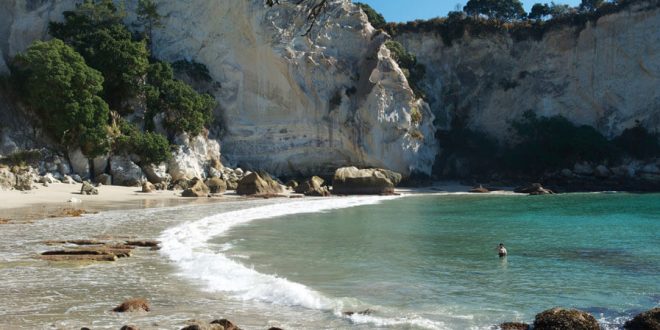Homework
Foreign travel is still somewhat of a lottery. Fear not, for we are blessed in our country with an astonishing range of landscapes, vistas, walks and sights.
Jim Sherwood picks just a (highly subjective) few of the best on a tour of Britain.
Britain is rich in beauties, some granted us by nature, some made by us, all of its own. What follows are just a few of those places that will remind you just how favoured our island is, how kind it has been to us and how fortunate we are to have such an abundance of beauty right here, on our doorstep.
Wheal Coates, south of St Agnes, Cornwall. A cathedral of a former tin mine, its pumping-engine house, ruined but stoic, pushes its stone, 19th-century chimney skywards still.
Polperro, Cornwall. Whitewashed houses dig their fingers in to the cleft of the coombe that leads down to a harbour as miniature as the seas beyond it appear vast. The final word in picturesque Cornish fishing villages.
Polzeath Beach, north of Wadebridge, Cornwall. Funnelled by the pincers of jutting headlands, the waves crash on Polzeath beach to the delight of surfers. On calmer days, the soft sand squeezes between your toes as if it were silk. Dartmoor, Devon. Travel anywhere here and you will encounter airy uplands, the granite outcrops sitting bold and spare, sliced by the cooling lava flows that formed them, coombes secreted amidst the tors, expanses of moorland and a Gothic inspiration. But head especially for St Michael’s Church at Brentor, perched gaunt and unyielding atop a column of rock that rises a hundred feet above the moors and the fields.
Grimspound, south of Moretonhampstead, Devon. In 2000 BC a Bronze Age community thrived here. The three-metre thick walls built to protect the circular enclosure still stand, guarding all that remains of the huts – the cooking pits and the stone slabs which served as beds. Behind you millennia of human history, before you an unending view of the moors that stretches long back into geological time.
Clifton Suspension Bridge, Somerset. Proof that humankind can be as monumental as nature. Black Down, south of Haslemere, Sussex. The track from the car park below gently traverses woodlands of birch, beech and Scots pine before delivering you to heaven. From the top of Black Down, cresting a sandstone ridge, you stare out over the woods and fields of the Weald. Lord Tennyson described is as “green Sussex fading into blue, with one grey glimpse of sea.”
Malmesbury Abbey, west of Swindon, Wiltshire. Visit just for the south porch to this 12th-century church, its eight arches depicting Biblical scenes. Some of the finest figurative Norman carving in Britain.
Thrift Wood, Essex. Once the county was blanketed in wildwood. Now all that is left to us is this wonderful sliver of coppiced trees, encompassed by ancient lanes and dense hedges. For you to marvel: a wood as it would have looked a thousand years back.
Blakeney Point, Norfolk. A narrow pebble spit that conducts you to a scene wilder with every step you take. At its tip you can watch as seals heave themselves out of the water, as wintering geese and ducks land, and, in summer, as plovers search for food.
Mam Tor, Derbyshire. A mountain that shivers off chunks of shale rock, shedding itself quietly into the scree slips and the valley below.
Bredon Hill, south of Evesham, Worcestershire. Imagine a flat, becalmed sea suddenly giving birth to a leviathan. That is Bredon Hill rising from the Vale of Evesham. It is crowned by an Iron Age fort and an 18th-century folly.
Alderley Edge, Cheshire. Draped in oaks, the escarpment climbs to 650 feet, from which you can see out over both the Pennines and the northern perimeter of the Peak District. Myth locates this as the sleeping place of King Arthur and his knights. The truth locates this as a place where, at the views, you will wish to keep your eyes wide open.
Castlerigg Stone Circle, Cumbria. The Lake District is not much in possession of flat ground, so it is no surprise that this plateau of even grass was chosen by peoples of the Bronze Age on which to erect a standing stone circle. About you the fells and peaks are an amphitheatre, wheeling and arcing, magicking the sky into a dome at the centre of which are the stones, assembled in their positions by man but addressing the universe.
Buttermere, Cumbria. Emerald slate columns flashed by foaming, diamond white waterfalls. The water sapphire blue in the sunlight. Clasped by the gold of the fells. The Lake District’s jewel.
From flat lands to the Highlands, ours is a diverse landscape
Whitby Abbey, Yorkshire. Stark and skeletal, backlit by an apocalyptic sunlight, a gaunt but ruined salient against godlessness. Little wonder that Bram Stoker, author of Dracula, chose Whitby as the disembarkation point for his demonic vampire.
Beaumaris Castle, north of the Menai Bridge. Impressed by castles? Wait until you see this bastion of mediaeval imperialism, the most technically perfect castle in Britain. Maybe in Europe.
Pistyll Rhaedr, mid Wales. A boa of water that is flung with carefree extravagance from the southern edge of the Berwyn mountains. The highest waterfall in Wales. If you want more Welsh waterfalls, trip along to Ystradfellte, a village lacing the southern lip of the Brecon Beacons National Park. From there you can visit Sgwd yr Eira (the Fall of Snow), the overhang to which is sufficiently deep as to create space for a footpath that leads walkers behind the curtain of thundering water.
Barafundle Beach, South Wales. Rock pools. Dunes. Cliff stacks. A velvety beach that reaches out to pristine waters. No roads, no car parks, no cafés. Just a grassy footpath. Perfect.
Jedburgh Abbey, Jedburgh. Some abbeys are just a column or arch or two. Not Jedburgh. Here the shell of the building is mostly as it should be.
It was founded in 1138, but, by the time a bunch of English soldiers ransacked it in 1544, it was still not quite complete. Now it never will be. And all the more wonderful it is for that.
The Highland Glens. Wilderness Britain at its unsurpassed. Narrow defiles. Craggy peaks. Intimidating corries. Near impossible passes. Lowering mountains. And skiing. Oh, and then, all of a sudden, quiet, gentle pastures. If you are hardy enough, tackle Aonach Mor and Glen Coe. The memories will stay with you forever.
Stirling Castle. Want to see where William Wallace and Robert the Bruce handed out a thumping or two to their English cousins? Climb, then, to the ramparts of Stirling Castle and gaze out over the battlefields of Stirling Bridge and Bannockburn.
Gaze out, too, at the magnificence of central Scotland.
Find your Great Britain. www.visitbritain.com
You can read more articles like this one in the latest edition of Thame Out.
 Thame Out The complimentary magazine for the Thame area
Thame Out The complimentary magazine for the Thame area


